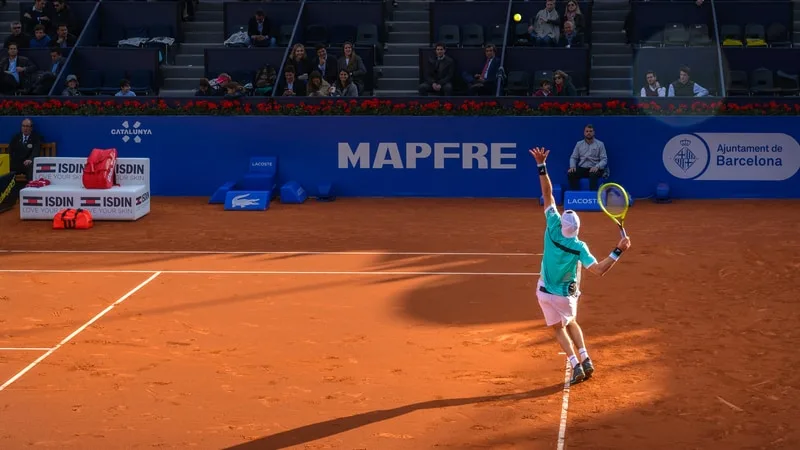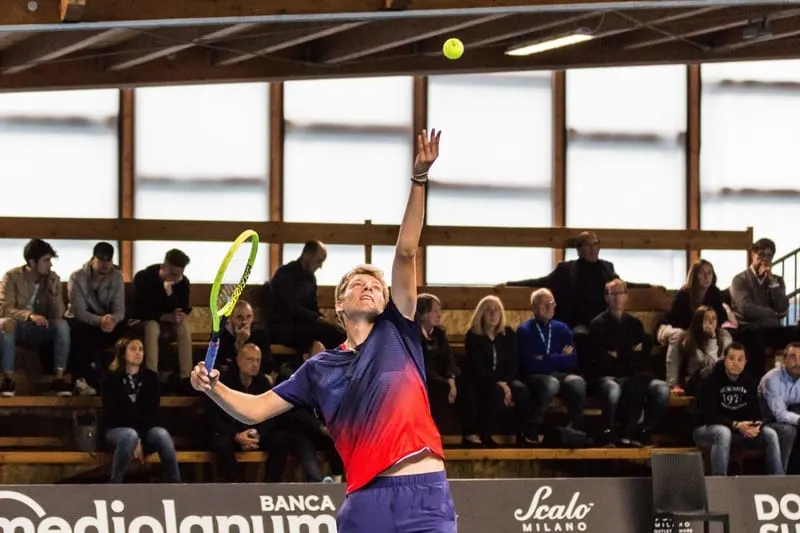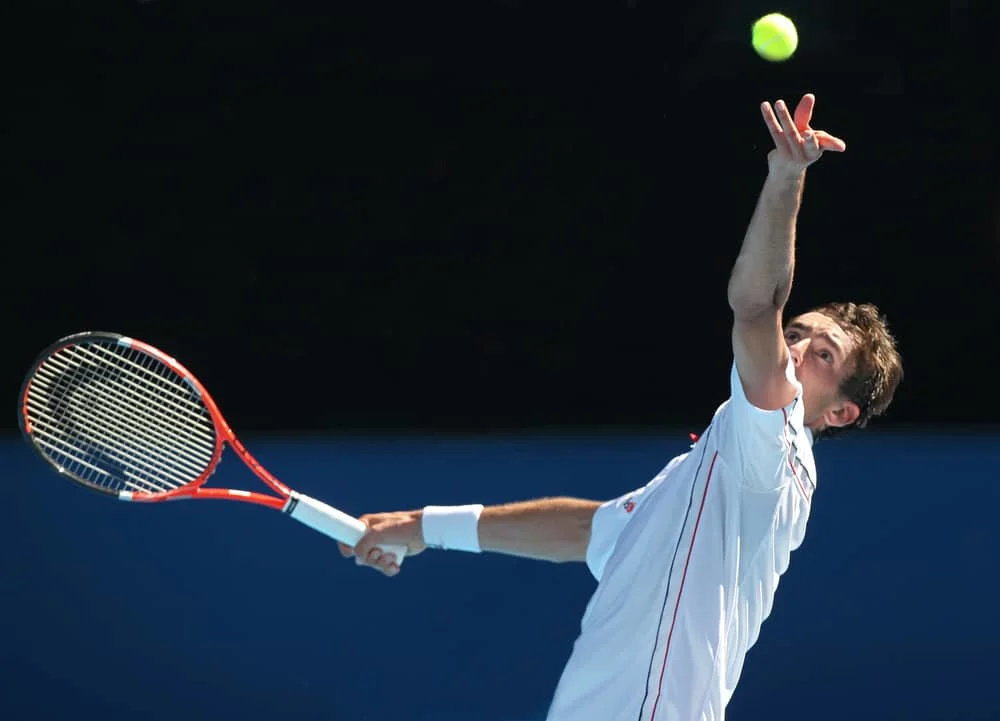
The kick serve is a hard serve to learn and it will take a lot of work to use it effectively, but with regular practice, you will be able to master it sooner rather than later.
But, what is a kick serve and how do you master it? We covered all of that in this article.
How Does The Kick Serve Work?
The kick serve relies on a relaxed arm that has enough power to whip around the body moving up and over before connecting with the ball. Due to the incredibly fast racket-head speed when performing a kick serve, the tennis player is able to put a large amount of top and side spin on the ball.
Due to the top spin, the ball will dip as it flies through the air and kick up off the court after it hits the ground.
This can make it very difficult for the opponent to get to the ball in time to return it correctly, as they can be forced out wide due to the side spin.
A well-rehearsed kick serve allows the player to have even more control over the ball than they would have with other types of serves.
Unlike a slice or flat serve, with a kick serve you actually toss the ball slightly behind you or above your head.
This allows you to brush up on the ball when you make contact and follow-through around the right side of the body.
When performed correctly, kick serves can be very difficult to return.
They are generally quite easy to hit, as they don’t have the pace of the flat serve, but they are difficult to get back, making them a great choice against competitors of all abilities.
A kick serve is particularly a great option when used on clay courts.
It can be used specifically to attack the weaker side of an opponent or to pull the player off to the side of the court so they will have more trouble getting to the serve.
One caution with a kick serve is that because it does bounce so high after hitting the court, it may allow an opponent to get underneath it and return a very shallow shot.
This will cause the return to fall short at your feet, which can be difficult to get back.
How to Master the Kick Serve | Step-by-step

1. The Grip For The Kick Serve
The kick serve requires a continental or eastern backhand grip. Usually, the eastern backhand grip helps you generate more spin, but the continental can help you hit the serve with a bit more power.
The eastern backhand grip requires players to put their base knuckle across the top level of the racket. The thumb should be extended across the side plane.
Not only is this a powerful grip, but it is also incredibly versatile.
The continental grip requires you to put your base knuckle further to the right, across the second level.
2. The Stance
Most people can use their normal stance when serving a kick serve, whether that’s a platform or a pinpoint setup.
However, a closed stance is going to be a much better option for a powerful kick serve. The front foot needs to be pointing at the net post if you are right-handed, and the left net post if you are left-handed. This makes it easy to quickly adjust for any differences in your stance when playing.
3. The Toss
The toss is the most important part of the kick serve.
It needs to be higher than normal and also needs to be above the head. While most serves require the ball to be thrown up slightly in front of the body, and sometimes slightly to the right, the kick serve toss needs to be above your head, or even slightly left.
When tossed correctly, it’s possible to get sufficient topspin on the ball.
4. The Kick Serve Swing Path
When it is time to hit the ball, make sure you focus on hitting upwards and outwards to the side of the body.
To accomplish this, players must understand how to snap their wrist. A wrist snap will add more power to the serve and provide the necessary spin.
Body rotation is also important (although older players who have limited mobility can enjoy a strong kick serve without as much rotation in the body).
Most players finish either by keeping their racket to their side below their elbow, or swinging all the way around the ball towards the belly button in a sideways arc.
Pros & cons of The Kick Serve

Pros
While not generally used as a first serve, kick serves are a great second serve option for a player to use during a match.
One of the biggest pros of using a kick serve is that it will bounce really high, and to the side, when it hits the court. Most players don’t expect this from a serve and will have trouble getting into position to correctly return the ball.
With practice, it’s also possible to control the amount of spin you put on the ball, sometimes hitting more topspin, than side spin, to get even more bounce.
The more topspin you can impart on the ball, the more it will dip. This gives you a much bigger margin for error to get the ball in the service box, meaning you can aim comfortably quite high over the net,
When used correctly and against the right opponent, a kick serve is a great weapon to pick up some free points.
Cons
One of the main downfalls of the kick serve is that it is generally very difficult to learn, and it is usually too hard for newcomers to learn how to use it effectively.
This means that players who want to use the kick serve need to be willing to put in a lot of practice to ensure that they are able to hit this serve correctly to get the best use out of it.
Another problem with the kick serve is that opponents who are comfortable taking shots early when the ball bounces will be able to easily return this serve. When this occurs, the turn on the ball will be reduced and the serve will not be nearly as difficult to return.
Practicing The Kick Serve
Mastering the kick serve takes practice and time, and running tennis drills are the best way to do this.
By continually practicing not only hitting the ball, but how to throw it up and slightly back, you will be able to quickly perfect a powerful kick serve.
After you have perfected your toss and know that it will land right above your head or slightly left, then you need to focus on slightly bending your knees and bringing your hips forward.
This will help to prevent you from trying to arch your back to hit the ball. Many players do this because they are aware of the ball being behind them and they panic when trying to hit it.
When you toss the ball, make sure to bend your knees and push your pelvis forward, which will keep you balanced and evenly distribute your weight.
Make sure that you do not look down when springing up and swinging.
By keeping your waist straight and even, you can fully extend up and control all of your upward thrust while uncoiling your body.
Once the racket drops, keep the elbow at shoulder level.
To make sure that you have plenty of power in your kick serve, pay attention that you swing up on the ball. This will allow you to not only clear the court but also correctly aim to the ball.
Kick Serve Drills
Here are some useful drills for the kick serve that I’m trying at the moment.
This is a great video if you’ve never tried the kick serve before.
Jaff Salzenstein has some great advice on breaking down the kick serve.
Here are some useful tips on getting in the right trophy position, and practicing the kick serve from there. This method helps eliminate some of the common mistakes that can occur early on in the swing.
Conclusion
If you are serious about improving your game, I think everyone should try and learn the kick serve. When you mix it up with slice and flat serves, it makes it a lot harder for your opponent to anticipate what you are going to do.
It takes practice, a lot of practice, but it’s more than worth it.
